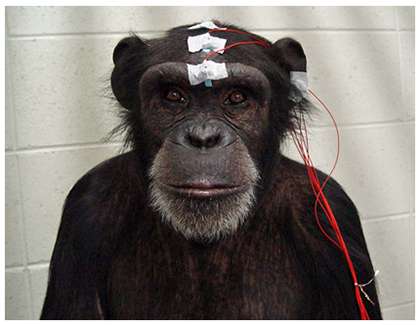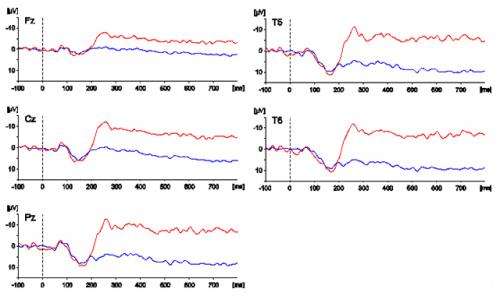Detection of affective facial expression in a chimpanzee: An event-related potential study

The chimpanzee brain responds to pictures depicting affective facial expressions of another chimpanzee. A research team led by Program-Specific Associate Professor Satoshi Hirata (Primate Research Institute), in collaboration with the Hayashibara Great Ape Research Institute and the University of Tokyo, measured the brainwaves of an adult female chimpanzee when she was observing pictures of chimpanzees showing affective expressions (affective pictures) and pictures without affective expressions (neutral pictures). The results showed that the brain waveforms in response to affective pictures differed from those for neutral pictures around 210 ms (0.21 sec) post-stimulus.
The results are reported in Scientific Reports, a journal published by Nature group.

Scientists once neglected the presence of emotions in nonhuman animals. However, people sometimes provide emotional accounts of animal behaviors in ordinary conversation. Brain science has revealed homologous structures and circuits in human and other mammalian central nerve systems; thus it is reasonable to assume that emotional or affective processes are also shared on some level. From an evolutionary perspective, emotion, or affective processing, is thought to be an effective system for generating a rapid, adaptive response to various environmental inputs. For example, fear upon seeing a predator is often linked with flight and escape behavior, which is vital for survival.
Advancement of non-invasive brain imaging techniques has allowed us to examine details of neural activities involved in affective processing in humans; however, no comparative data are available for chimpanzees, the closest living relatives of humans. To address this lack of information, we examined scalp surface brain potentials, or electroencephalography (EEG), in response to affective pictures in a chimpanzee.

After a long period of step-by-step training, we succeeded in measuring EEG in a fully-awake adult chimpanzee for the first time. In the present experiment, we measured event-related potentials (ERPs) in response to pictures which were a subset of the stimuli used in the chimpanzee memory experiment, in which enhanced memory for affective over neutral pictures was found. In sum, the present study tested whether differential brain response to affective and neutral pictures could be found that coincided with evidence of enhanced memory of affective pictures.
The results revealed a differential brain potential appearing 210 ms after presentation of an affective picture, a pattern similar to that in humans. Studies with humans suggest that the component in this latency range can be interpreted as reflecting amygdala processing of affective information, and believed to reflect selective attention to affective images of intrinsic relevance. The present study suggests that this process is similar between humans and chimpanzees. The results have also implications for the evolutionary foundations of emotional phenomena, such as emotional contagion and empathy.
More information: Hirata, S. et al. Brain response to affective pictures in the chimpanzee, Scientific Reports, 3, 1342; DOI:10.1038/srep01342 (2013).
Journal information: Scientific Reports
Provided by Kyoto University















